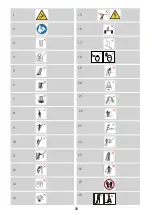
unpacked? Check if all parts are with you and
the device is working.
→
Risk analysis:
conduct these before use.
Important: The regulations of the country in
which the ladder is used must be observed.
→
Cleaning:
Dirt such as damp paint, dirt or snow
should be removed before use.
→
Health:
Just climb the ladder when you are fit!
Illness, the use of various medicines as well
as alcohol and drugs can impair your safety in
use.
→
Maintenance and monitoring:
Check the
ladder on function and possible damages on
every working day. Do not use damaged ladders!
→
Commercial:
The ladder is used commercially?
Then it has to be checked regularly.
→
Applicability:
Depending on the type of work
to be done, you must check whether the ladder
is suitable for it.
→
Temperature:
The ladder may be stored at an
ambient temperature of minus 20 to plus 60
degrees.
The installation
→
Positioning and locking:
Check that all
elements to be locked are properly locked in
place. The ladder may only be placed on its feet,
not on the glazing bars.
→
The angle:
inclination angle as ladder step = 70
degrees with respect to the ground, as a ladder
= 65 to 70 degrees with regard to the ground.
Cross-check: The glazing bars of the ladder
must be meet scales accordingly.
→
Stability:
The ladder must be level, level and
safe, not inclined to the side! Setting up on a
slippery surface or even an unloaded ladder
foot are No Gos. A suitable substrate must be
cleaned or the ladder secured against slipping.
→
The wall surface:
As a leveling ladder, it must
be leaned against a solid, level surface and
secured by tying, if possible. Important: Do not
hang up with the glazing bars, but with the side
pipes!
→
Position:
Do not bring from above into a new
position!
→
Environment:
Make sure that people walking
by, cars or objects do not hit the ladder.
→
Electricity:
Make sure that electricity, such as
overhead lines, does not hinder you.
On the ladder
→
Maximum load:
150 kg
→
Stability (as ladder step):
Do not use the
ladder until fully extended and unfolded with
the strap stretched out. All glazing bars'
segments must be locked. Check the locks.
→
Stability (as a ladder):
Always pull the ladder
up to full height. Lean against the contact
surface with the back. Important: A glazing bar
segment on the back must be pushed together.
As a result, the ladder with freely hanging
backrest stands stably on the front feet.
→
Rear sides:
If the ladder is used as a step
ladder, DO NOT climb on the back!
→
Higher glazing bars
●
as a stamding step WITH leg support / grab
handle:
When used as a ladder step with
leg support / grab handle, DO NOT stand on
the top three glazing bars, but below the
hinge joint
●
As l stamding step WITHOUT ladder
support / handle:
In this case, do not stand
on the top two glazing bars and not closer
than 60 cm to the top glazing bars
●
As a ladder:
Do not stand on the top four
glazing bars
That will not do:
You want to have something of your ladder for
a long time. So, you must protect especially the
telescopic poles and the glazing bar segments
from dirt and damage. And also yourself. Hence:
→
DO NOT use the ladder as a step or stool in
a collapsed condition!
→
DO NOT use hanging
→
DO NOT remove or use if it is upside down
→
DO NOT use in a horizontal position or even
as a bridge
→
DO NOT use in dirty environment or work that
causes dirt (eg masonry or painting work)
35
Summary of Contents for EVO-PROSTEP
Page 1: ...DK NL UK FR DE RO PL NO ES I T...
Page 2: ...1...
Page 3: ...10 mm 2...
Page 4: ...3 D C A1 B1 B2 A2 1...
Page 5: ...4 F E 2...
Page 6: ...5 G H 1 2 3 4 3...
Page 7: ...max 150 kg 6...







































